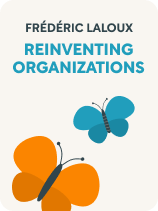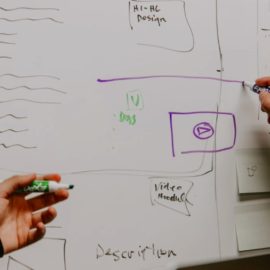

This article is an excerpt from the Shortform book guide to "Reinventing Organizations" by Frédéric Laloux. Shortform has the world's best summaries and analyses of books you should be reading.
Like this article? Sign up for a free trial here.
Which is it better to use—job titles or job roles? What will the role of the CEO be in the future?
In Reinventing Organizations, Frederic Laloux identifies an emerging breed of company that operates from a new set of rules. Laloux claims that humanity is on the cusp of a new paradigm in how we organize ourselves and suggests ways that businesses can adapt to this transition that will elevate how we work and how we live.
Keep reading for an overview of this intriguing book.
Reinventing Organizations by Frederic Laloux
Modern organizations—governments, religions, major corporations—have produced social and technological advances that have lifted humanity into an age of abundance. However, those same organizations restrict individual growth and have led to rampant consumption of resources. Recognizing this, some emerging organizations now operate from a new set of rules that veer away from hierarchical structures based on power and achievement and instead embody self-direction, authenticity, and a collective higher purpose.
In Reinventing Organizations, Frederic Laloux traces the history of organizational structures to show that each leap forward in how we build our institutions corresponds to an equivalent shift in how we view ourselves and the world.
Laloux is a business consultant whose work gave him an understanding of how organizations function. While looking at companies that were successfully pioneering new approaches to work and management, he found an emerging pattern that prioritizes workers’ inner motivations and makes better use of their full human potential.
We’ll trace the stages of organizational development from ancient kingdoms to modern corporations. Laloux uses a color-code shorthand to denote the different organizational models (Amber, Orange, Green, and Teal). For clarity, we will instead use the terms traditional, modern, inclusive, and visionary. We’ll introduce the practices and values that Laloux says are inherent in the next level of human organization while touching on the steps needed to implement these practices today.
The Stages of Organizational Development
Laloux traces a series of paradigm shifts in organizational structure over the past 10,000 years, arguing that each transition goes hand in hand with a change in how we think about the world. Each type of organization evolved to fill a niche and may still be the best option under certain circumstances. Organizations commonly share aspects of several different paradigms at once, including traditional, modern, and inclusive structures.
Traditional Organizations
According to Laloux, the first formal organizations were rooted in strict hierarchical authority structures that maintained their power through tradition and adherence to collective norms. These traditional structures can still be found today in government agencies, militaries, religions, and schools.
Laloux writes that one key innovation of traditional organizations was that authority became invested in positions instead of persons and that rules were encoded into systems of laws. Tradition-based groups thrive best in times of stability, when rules are obeyed and no one deviates from their roles.
Modern Organizations
Because traditional organizations relied heavily on long-term stability and unquestioned authority, they faltered when the Scientific and Industrial Revolutions launched a period of accelerated change. Modern organizations developed, and they prized innovation over tradition, inquiry over dogma, and the merit of individuals over their preordained social class.
Laloux writes that fixed hierarchies of power were superseded by collective business enterprises, the precursors of modern corporations. Modern organizations retain a hierarchical structure, but, in the modern model, previously rigid barriers in class and status are less strict. Direction, goals, and objectives come from the top, but it’s those at the bottom who determine how those goals are put into practice.
Laloux acknowledges that modernity exacts a heavy toll in the form of greed and overconsumption.
Inclusive Organizations
Inclusive groups took root in the 1960s. Laloux claims that inclusive organizations break down traditional and modern power structures by emphasizing group consensus. Whereas modern organizations’ obligations are to their shareholders, inclusive organizations have a wider scope of duty to their employees, their communities, and the environment. Those at the top are “servant leaders” whose role is to support those who work beneath them. Decisions are often based on the organization’s values and culture.
Laloux says that, while inclusive organizations subvert the power structures of tradition and modernity, they haven’t been successful at coming up with workable replacements. Still, Laloux doesn’t see inclusive structures as a failure but rather as a necessary stepping stone to the next stage of humanity’s organizational development.
Visionary Organizations
Laloux dubs all previous structures as “ego-driven” organizations, whereas what follows is the beginning of a different kind of development. He predicts that next-level visionary organizations will see themselves as living things not beholden to the egos of individual members.
Visionary organizations, according to Laloux, will merge the enlightened aspects of inclusivity with the practical savvy of modernity. They will be based on principles of self-management, with no structured hierarchy or push for group consensus.
In his research, Laloux studied 12 present-day organizations that model the attributes he believes will characterize this new type of organization. He believes his results suggest the path that future development may take.
How Visionary Organizations Work
Laloux identified a common thread of practices and philosophies that unites these groups in outlook and approach. These include new assumptions about how people work, fluid power structures, self-management, peer-driven performance, and healthy techniques for conflict resolution.
Fundamental Assumptions
Visionary systems believe that people are generally reasonable and can be trusted to make good decisions. When we’re set free with the trust that we’ll work toward a purpose, Laloux finds that we’re revealed to be creative, intelligent, and willing to hold ourselves accountable for our own mistakes. Furthermore, says Laloux, peer pressure is a far better regulator than punitive action from a battery of bosses.
Non-Hierarchical Structures
Visionary organizations’ most radical departure from modern structures is the elimination of the top-down pyramid. Visionary structures aren’t “flat” but fluid. Laloux identifies three different structural approaches that visionary organizations use.
Approach #1: Organizations are divided into small, autonomous teams who work in parallel.
Approach #2: The individual contractors who make up the organization negotiate their roles and define their duties through one-on-one agreements.
Approach #3: The structure recommended by the Holacracy management system involves nested teams that work together when full autonomy isn’t possible. In this system, Laloux explains, groups of different sizes and authority take shape to address different levels of responsibility—a team of members from all parts of the company pursues the organization’s overall purpose, while smaller teams focus on specific aspects of it.
Roles Replace Titles
In addition to moving away from hierarchies, visionary organizations do away with job descriptions that spell out each person’s duties. Instead, a member of a visionary organization has “roles” they can pick up, create, or discard. Laloux says that these roles emerge organically from the combination of a person’s talents and the company’s needs.
Decision-Making
The most counterintuitive aspect of visionary organizations is their approach to making decisions. Laloux explains that anyone can make a decision for the company, so long as they seek advice beforehand. Everyone impacted by the choice should be consulted. Laloux makes it clear that the advice-seeking process is not a quest for consensus. Once the appropriate advice has been given, the employee can make whatever decision they feel is right.
Performance Management
Performance in visionary organizations is measured at the level of teams, whose results are available for all to see. Individual feedback is given by peers, and that pressure is often sufficient for individuals to judge their own performance.
The Feedback Process
Visionary companies approach interpersonal feedback sessions from a perspective of teaching and learning.
Conflict Resolution
The first step is for colleagues to attempt to resolve their issues on their own. Failing that, two people in conflict can nominate a mediator whom both of them trust. The mediator can guide the process but cannot enforce a solution. If the mediator’s help isn’t enough, a panel can be convened, conferring with the CEO if needed.
Setting Compensation
Without formal hierarchies or HR departments, pay is either set by peer review or by the employees themselves.
The Culture of Visionary Organizations
Though cultures are unique to every organization, Laloux identifies many commonalities among the companies included in his research.
Organizational Purpose
The strongest driver of the company’s culture is its overriding purpose in the world. As Laloux explains, this purpose is not dictated from on high but emerges organically from the work the company does and the values of its members. This purpose replaces profitability as the reason for the company’s existence while guiding how it interacts with competitors, clients, and the community at large.
Visionary organizations view profits as a byproduct of fulfilling the company’s purpose.
Authenticity
Visionary companies are places where employees find a safe space to show up as themselves, be treated as adults, and flourish in an environment of healthy collaboration. In order for people to bring their whole selves, the company must be a safe space to do so. Laloux shows that visionary companies accomplish this by training everyone in leadership skills such as listening, coaching, gratitude, and authenticity. Visionary organizations also create avenues for personal development.
Transparency and Trust
These companies’ high-minded ideals rely entirely on the trust between workers and the organization. Therefore, says Laloux, it’s imperative that organizations demonstrate their trust by allowing everyone to act responsibly without a system of controls, in particular doing away with the compartmentalization of information. Laloux argues that total transparency is essential in building trust between an organization and its members.
Implementing Visionary Practices
Laloux concludes by suggesting ways that visionary concepts can take root in organizations.
Visionary Leadership
For an organization to function from a visionary perspective, it’s vital that the CEO, the board, and principal investors buy into the concept. While the CEO acts as the company’s public face, their job is to refrain from using power. Instead, CEOs should model visionary principles, such as going through the advice process before making decisions, being transparent in communications, and holding themselves accountable. The CEO must bring their whole, authentic self to the workplace.
Laloux also insists that visionary companies be very selective about who serves on their boards. They will have to understand the organization’s higher purpose and not put pressure on the organization to please investors to the detriment of following the company’s higher calling.
Creating a Visionary Organization
Whether you’re starting a new company or steering one that already exists, Laloux suggests introducing workers to concepts of self-management, extolling the virtues of wholeness in the workplace, and embedding the company’s purpose into every aspect of work. To do this, Laloux recommends you begin by educating all team members on the self-management practices the company will adopt.
The next components that Laloux says should be put in place are the advice process for making decisions, a method for conflict resolution, and tools for peer evaluation. In conjunction with this, leaders should implement safe space guidelines and provide training in collaboration and communication skills.
Companies based on an older paradigm will have to implement self-management gradually, with the full approval of the board and investors.
Laloux contends that visionary organizations represent the wave of the future and that adopting their practices now may better position modern-day companies to weather the changes of tomorrow.

———End of Preview———
Like what you just read? Read the rest of the world's best book summary and analysis of Frédéric Laloux's "Reinventing Organizations" at Shortform.
Here's what you'll find in our full Reinventing Organizations summary:
- The practices and values that are inherent in the next level of human organization
- A look at the paradigm shifts in organizational structure over the past 10,000 years
- How to implement visionary practices at your company






